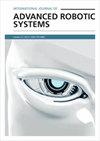Robotic scanning free-space measurement system for electromagnetic performance evaluation of curved radar absorbing structures
IF 2.1
4区 计算机科学
Q2 Computer Science
International Journal of Advanced Robotic Systems
Pub Date : 2022-07-01
DOI:10.1177/17298806221114554
引用次数: 0
Abstract
Radar absorbing structures are manufactured for stealth missions and total quality inspection applies to evaluate their performances before assembly to stealth weapon systems. This study adopted a six-axis robot arm to move a target specimen in a scanning free-space measurement system for electromagnetic performance evaluation. The six-axis robot arm completely enables the system to maintain the specimen at the focal point of the antenna and solves the issue of curvature effect on the return loss results of the curved specimens, faced in the two- and three-axis scanning free-space measurement systems. The six-axis robotic scanning free-space measurement system uses a RobotStudio to extract the position and orientation of each target point on the specimen to be evaluated and uses a robotic scanning algorithm to transform all the points into a scan path. The system was verified by variable and constant curvature radar absorbing structure specimens with frequency selective surfaces. Return losses (S 11s) of the nonsymmetrical cambered airfoil specimen and S-shaped double curvature specimen that could not be accurately evaluated with a three-axis stage-based scanning free-space measurement system were measured by the six-axis robotic scanning free-space measurement system. All the specimen results adhere to the theoretical parameters of the specimen. The transition region results of the S-shaped specimen were studied using effective radius of curvature. Finally, the inspected results of the S-shaped specimen were curvature compensated to check the effect of negative and positive curvature on the specimen resonance frequency performance.用于曲面雷达吸收结构电磁性能评估的机器人扫描自由空间测量系统
雷达吸波结构是为隐身任务而制造的,在装配到隐身武器系统之前,全面质量检查适用于评估其性能。本研究采用六轴机械臂在扫描自由空间测量系统中移动目标试样进行电磁性能评估。六轴机械臂完全使系统能够将试样保持在天线的焦点上,解决了二轴和三轴扫描自由空间测量系统中曲率对弯曲试样回波损失结果的影响问题。六轴机器人扫描自由空间测量系统使用RobotStudio提取待评估标本上每个目标点的位置和方向,并使用机器人扫描算法将所有点转换为扫描路径。采用频率选择曲面的变曲率和恒曲率雷达吸波结构试样对系统进行了验证。采用六轴机器人扫描自由空间测量系统,对三轴台阶扫描自由空间测量系统无法准确评估的非对称弧面翼型和S型双曲率翼型的回波损失进行了测量。所有试件结果均符合试件的理论参数。采用有效曲率半径对s形试样的过渡区结果进行了研究。最后,对s形试件的检测结果进行曲率补偿,验证负曲率和正曲率对试件谐振频率性能的影响。
本文章由计算机程序翻译,如有差异,请以英文原文为准。
求助全文
约1分钟内获得全文
求助全文
来源期刊
CiteScore
6.50
自引率
0.00%
发文量
65
审稿时长
6 months
期刊介绍:
International Journal of Advanced Robotic Systems (IJARS) is a JCR ranked, peer-reviewed open access journal covering the full spectrum of robotics research. The journal is addressed to both practicing professionals and researchers in the field of robotics and its specialty areas. IJARS features fourteen topic areas each headed by a Topic Editor-in-Chief, integrating all aspects of research in robotics under the journal''s domain.

 求助内容:
求助内容: 应助结果提醒方式:
应助结果提醒方式:


